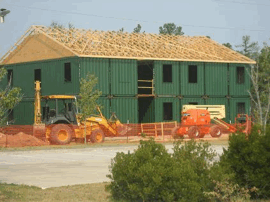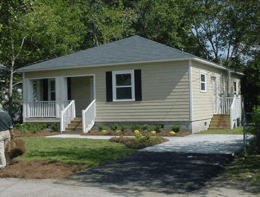Out of the Box Housing
Air Date: Week of August 21, 2009

A hurricane-proof house under construction. (Courtesy of SG Blocks)
The increasing push to reuse materials has given some entrepreneurs a bright idea. Living on Earth’s Ingrid Lobet reports on how steel cargo shipping containers are becoming homes.
Transcript
CURWOOD: Shipping containers are those big steel boxes you find at ports, railyards – and loaded on trucks. And usually they’re used just for that – shipping. But as Living on Earth’s Ingrid Lobet reports, some entrepreneurs are transforming containers into home sweet home.
[FORKLIFT BEEPS]
LOBET: Forklifts move exhibits into place at the EcoBuild America show in Orange County, CA. David Cross of SG Blocks stands at his exhibit, a steel box with one half converted into a living space.
CROSS: What we're looking at here is a forty-foot cargo container: eight feet wide, it's nine and a half feet tall and it's forty feet long.
[BANGING ON SIDE OF METAL CONTAINER]
LOBET: One side of the container has been removed, and window and door openings have been cut into the sides and ends.

The right side of this home is an addition made of shipping containers.(Courtesy of SG Blocks)
LOBET: Cross says buildings made this way can withstand 175 mile per hour winds. And the containers or 'blocks' can be stacked, cut, and integrated by an architect into various styles. In fact in several buildings SG Blocks has helped build, it's hard to discern the containers within.
CROSS: We're the bones of it, but what the exterior and the interior looks like is up to the architect and their clients.
HINCHLIFF: What's funny these days – it seems to be a trend towards exposing the shipping container and utilizing that as an industrial look.
LOBET: That's Bill Hinchliff of ConGlobal Industries. His company partners with SG Blocks.
Typically how a projects works is a homeowner or developer hears about the shipping containers, and then puts SG Blocks in contact with their architect for the design. ConGlobal does the welding and custom cutting. The contractor on site pours a foundation. Then the customized containers are delivered and welded via plates to the foundation wall. This way the bones of most buildings can be stacked in a day, making way for electricians, plumbers and drywall trades.
The finished product isn't always cheaper, but can be faster and stronger than a frame building. And Cross says the treated steel would hold up being underwater for several weeks, as many homes were after Hurricane Katrina.
CROSS: Yes you'd still have to take off your drywall and address that, but fundamentally your framing system behind the package is still sound.
LOBET: There's also the reuse aspect. The pieces removed from the box are melted down for new steel, so all aspects of the container get a new life. Cross says he's been getting a lot of calls.
CROSS: This is the old Buddy Guy musician, this is an overnight success 20 years in the making.
LOBET: SG Blocks isn't the only company to consider shipping containers for homes. There's a development called Container City in the UK. And designer Jennifer Siegal, who specializes in sustainable prefabricated buildings, created a container house in Los Angeles.

A hurricane-proof house under construction. (Courtesy of SG Blocks)
SIEGAL: Most building departments around the country are not ready to accept the shipping container as a form or as a building element as of yet
LOBET: Still she believes containers hold promise, as long as people use them creatively, cutting windows, stacking them, putting on different finishes.
SIEGAL: Then yes, I think that there’s an incredible demand for low to moderate income housing, office space – all kinds of ways in which the containers can be sewn into the fabric of the city.
LOBET: Or wherever building speed, wind resistance, and the desire to reuse are priorities.
For Living On Earth, I'm Ingrid Lobet in Anaheim, CA.
CURWOOD: To see photos of homes and buildings made with shipping containers, visit our website - loe.org.
Links
Living on Earth wants to hear from you!
Living on Earth
62 Calef Highway, Suite 212
Lee, NH 03861
Telephone: 617-287-4121
E-mail: comments@loe.org
Newsletter [Click here]
Donate to Living on Earth!
Living on Earth is an independent media program and relies entirely on contributions from listeners and institutions supporting public service. Please donate now to preserve an independent environmental voice.
NewsletterLiving on Earth offers a weekly delivery of the show's rundown to your mailbox. Sign up for our newsletter today!
 Sailors For The Sea: Be the change you want to sea.
Sailors For The Sea: Be the change you want to sea.
 The Grantham Foundation for the Protection of the Environment: Committed to protecting and improving the health of the global environment.
The Grantham Foundation for the Protection of the Environment: Committed to protecting and improving the health of the global environment.
 Contribute to Living on Earth and receive, as our gift to you, an archival print of one of Mark Seth Lender's extraordinary wildlife photographs. Follow the link to see Mark's current collection of photographs.
Contribute to Living on Earth and receive, as our gift to you, an archival print of one of Mark Seth Lender's extraordinary wildlife photographs. Follow the link to see Mark's current collection of photographs.
 Buy a signed copy of Mark Seth Lender's book Smeagull the Seagull & support Living on Earth
Buy a signed copy of Mark Seth Lender's book Smeagull the Seagull & support Living on Earth

